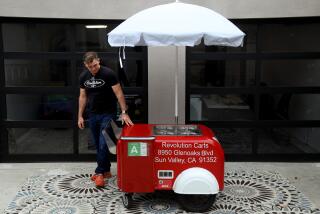Cart Inventors Give Hot Dog Sellers New Tool to Push Wares
- Share via
Other inventors might spend their nights dreaming up a better mousetrap, but Marion Ruggles and Bill Nussbaum needed something they could sink their teeth into: a project with some meat; a gadget that really cooked.
They also wanted a product that would fit their disparate personalities, and there are precious few things that a one-time dune buggy maker and a transplanted Queens native could possibly manufacture and market--together.
So, thanks to Ruggles and Nussbaum, owners of an Anaheim-based custom fiberglass company called Imagineering, the world now has what the partners modestly call the first aerodynamically sound, fiberglass hot dog cart.
And it’s colorful, too.
Vendors now can hustle their product in carts from azure to yellow in color, with finishes ranging from stripes to--you guessed it--a metal flake paint job reminiscent of the dune buggies Ruggles used to make through a now-defunct company called Sand Chariots.
This is “not just a service bar on casters,” one Imagineering brochure brags, but a cart that is “equally at home in a million-dollar mall or on an inner-city street corner.”
So, why would anyone buy a streamlined steam table on wheels?
First, because street-corner hot dog vending has been enjoying something of a boom.
Second, because the fiberglass cart generally weighs--and costs--less than competing brands. At 250 pounds and priced at $3,000 plain or $6,000 with the works, the Imagineering cart is light on both the wallet and the biceps, said Nussbaum, who hails from the Queens neighborhood of Jackson Heights.
Nussbaum and Ruggles have just begun turning out production models of their fiberglass carts and, while their company has yet to make a sale, the dogged duo’s goal is to market 200 carts this first year of operation and 500 annually thereafter.
Sausage industry experts say that Denver-based Carts of Colorado is one of the largest cart-manufacturing firms nationwide and is Imagineering’s stiffest competition.
Richard Murray, the Denver firm’s western sales manager, says his company’s stainless steel hot dog carts cost “in the $7,000 range” and weigh about 300 pounds.
Money and mass aren’t the only selling points for the Imagineering cart, said Ruggles as he smashed one of his creations with a hammer. The only thing damaged was a switch that turns on the propane tank; the fiberglass absorbed the shock, but the switch flew off.
“This cart can take all kinds of abuse,” Ruggles said, “but we’re going to have to, uh, get a better switch.”
Imagineering’s culinary chariot has a fiberglass body with stainless-steel food preparation area and sink, pneumatic wheels and a beverage area that can hold 60 cans of soda when packed with ice or 100 without ice. It is built in modules, so a second sink can be added when local health codes require it.
Nussbaum calls the creation “truly fast food for the true entrepreneur.”
“From the standpoint of the operator, all they need is $5,000 to $6,000, and they’re in business,” he said. “Now, don’t turn up your nose at it. You can make a good $25,000 to $30,000 a year with one of these.”
While most New Yorkers are accustomed to wieners on wheels, Californians have only seen such rolling repasts since 1985, when the state Legislature amended the Health and Safety Code to allow unpackaged foods such as popcorn, nuts and hot dogs to be sold on moving carts.
In fact, until the past year or two, tight local standards kept the vending business small and not very lucrative, said Fran Altman, a spokeswoman for the National Hot Dog and Sausage Council.
“One of the reasons the whole vending business has not taken off is because communities are hesitant from the sanitation standpoint,” Altman said. “But, generally speaking, street vending (now) is overcoming past problems.”
What this widespread ban on street vending of hot dogs has created is a market waiting to be tapped.
“There’s about 1.5 billion hot dogs sold every year,” Altman said. “Most of them are eaten at home. There’s probably an opportunity for more of them to be sold away from the home. In the entrepreneurial field, it’s something people are interested in.”
That is a fact that Nussbaum and Ruggles are aware of and plan to exploit.
“We kind of fell into the true niche type of market,” Nussbaum said. “Nobody to our knowledge is doing it in fiberglass. . . . With the current market, it looks like everyone (else) has their own version of the square box. With the exception of graphics, it’s a very much look-alike market.”
More to Read
Inside the business of entertainment
The Wide Shot brings you news, analysis and insights on everything from streaming wars to production — and what it all means for the future.
You may occasionally receive promotional content from the Los Angeles Times.











